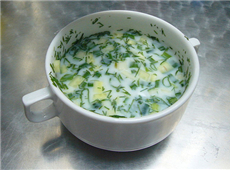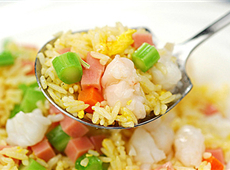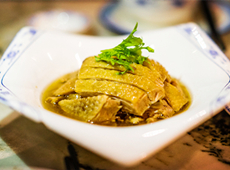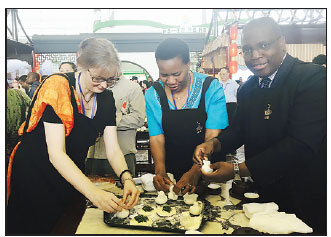Yangzhou celebrates tradition with international festival
By:Liu Zhihua(China Daily)
2015-10-01
The influences of culture and history on food traditions are felt in every locale, and earlier this month, people in Yangzhou, Jiangsu province, enjoyed a festival that showcased not only their own culinary specialties but also those of other places along the ancient Silk Road, including Italy and Turkey.
Yangzhou is a traditional center of Huaiyang cuisine, one of China's four major cooking styles. It is famous for its light, fresh taste and exquisite cuts, and now many time-honored restaurants, including Yechun and Fuchun teahouses, have become must-visit spots for tourists who want to have a taste of authentic Yangzhou flavors.
Locals follow the practice of "skin wraps water in the morning, and water wraps skin in the evening", that is, to eat steamed buns and tea in the morning, and to enjoy time in bathhouses at evening.
The city's signature breakfast is often composed of crab-roe soup dumplings, sanding bao (steamed bun stuffed with diced pork, chicken and bamboo shoots), jade-colored steamed dumplings that are stuffed with green vegetables, and qianceng cake, literally thousand-layer cake. All are very delicious, especially when accompanied with a cup of green tea.
A local friend told me that Yangzhou steamed buns or dumplings use a traditional method to ferment wheat flour dough, in order to make the skin of the buns and dumplings soft but chewy.
My favorite was qianceng cake, which tasted slightly sweet and was soft as cotton, even once it became cold.
The pickled mushroom with shrimp paste was also good, with its chewy, meaty and juicy texture, and savory flavor.
Tang gansi, or boiled scaly tofu threads, a famous Huaiyang dish, should also be tried in Yangzhou. Chefs slice tofu into very tiny shreds, then soak the shreds in boiling water before dressing them with specially made seasoning sauce.
It is said that Yangzhou's version of tang gansi sets itself apart from others, because Yangzhou tofu is neither too hard nor soft, and has an aromatic flavor.
Shizitou, or lion-head meatball, is very representative of Huaiyang cuisine. Chefs often use both lean and fatty pork to make the meatball to ensure it is tender and juicy.
Last but not the least, Yangzhou's namesake fried rice speaks to that exquisite cuisine. Traditionally, eight ingredients, including egg, shrimp, corn, ham, mushroom, and carrot are fried together with rice and spices, to make a bowl of refreshingly aromatic fried rice.
The festival celebrated the fact that Yangzhou was once a meeting point on the overland and maritime Silk Road. To celebrate its 2,500-year history, the China Public Diplomacy Association, the embassy of Italy in Beijing and the World Association of Chinese Cuisine jointly supported the Yangzhou government to initiate the four-day Silk Road Cuisine Display - Yangzhou Week food festival, starting from Sept 11.
The celebration included cooking technique shows performed by master Chinese and Italian chefs, sessions for people interested in learning how to make steamed buns, and conferences attended by Chinese and Italian government officials and entrepreneurs to seek economic cooperation between Yangzhou and Italy.
Huaiyang cuisine has an honored place in Chinese culture and has been prominent in official dining. It was featured at the first state banquet for the People's Republic of China in 1949, at China's 50th anniversary banquet in 1999, and at a state dinner for then US president George W. Bush hosted by Chinese president Jiang Zemin in 2002.
|
Foreign delegates to the food festival attend a session on making Yangzhou steamed buns.Liu Zhihua / China Daily |
 Okroshka
Okroshka
Okróshka is a cold soup of Russian origin. The name means to crumble into small pieces.
 Yangzhou Fried Rice
Yangzhou Fried Rice
Yangzhou Fried Rice is perhaps Yangzhou's most well-known dish.
 Boiled Salted Goose
Boiled Salted Goose
Goose is indispensable on Yanzghou people's banquet.
